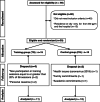Benefits of self-paced concurrent training on lung function, cardiopulmonary fitness and fatigue perception in patients with multiple sclerosis
- PMID: 39439238
- PMCID: PMC11524201
- DOI: 10.1080/17582024.2024.2404385
Benefits of self-paced concurrent training on lung function, cardiopulmonary fitness and fatigue perception in patients with multiple sclerosis
Abstract
Aim: Studying the effects of self-paced concurrent high-intensity interval training and resistance training (HIIT-RT) on respiratory function, cardiopulmonary fitness and fatigue perception in patients with multiple sclerosis (PwMS).Methods: Twenty-three PwMS were randomized into a 12-week training group (three times per week) (TG, n = 11) or a control group (CG, n = 12). Lung function (spirometry), aerobic capacity (graded cardiopulmonary-exercise-testing) and perceived fatigue (Fatigue Severity Scale (FSS)) were evaluated pre- and post-intervention.Results: The forced vital capacity (p = 0.036, Hedges'g (g) = 0.93), forced expiratory time (p = 0.045, g = 0.88), peak expiratory flow (p = 0.043, g = 0.89) increased in TG compared with CG. The TG showed an increase in peak aerobic power (p = 0.004, g = 1.34) and peak oxygen uptake (p < 0.001, g = 2.58) compared with CG. There was a decrease in ventilatory equivalent for carbon dioxide (p = 0.02, g = 1.02) and FSS scores (p < 0.001, g = 1.72) in TG comparatively with CG.Conclusion: 12-week self-paced HIIT-RT enhanced lung function as well as aerobic fitness, and alleviated fatigue perception in PwMS.
Keywords: concurrent training; fitness testing; metabolic responses; perceived fatigue; relapsing-remitting multiple sclerosis; spirometry.
Plain language summary
[Box: see text].
Conflict of interest statement
The authors have no competing interests or relevant affiliations with any organization or entity with the subject matter or materials discussed in the manuscript. This includes employment, consultancies, stock ownership or options and expert testimony.
Figures



References
-
- Sebastião E, Hubbard EA, Klaren RE, et al. Fitness and its association with fatigue in persons with multiple sclerosis. Scand J Med Sci Sports. 2017;27(12):1776–1784. doi: 10.1111/sms.12752. - DOI - PubMed
-
• This cross-sectional study revealed that poor cardiopulmonary fitness (VO2peak) was a predictor factor of perceived fatigue (R2 = 13%) in patients with multiple sclerosis (PwMS), thus highlighting the importance of investigating these parameters in the same study, and providing a means to discuss fatigue alleviation.
Publication types
MeSH terms
LinkOut - more resources
Full Text Sources
Medical
Miscellaneous
